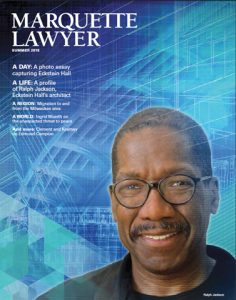 Has it been 10 years already? Yes, the tenth anniversary is at hand for the groundbreaking for Eckstein Hall on May 22, 2008.
Has it been 10 years already? Yes, the tenth anniversary is at hand for the groundbreaking for Eckstein Hall on May 22, 2008.
How have things worked out? Anyone who spends time—and especially anyone who spends a lot of time—in the home of Marquette Law School knows the answer: Very well.
The new issue of Marquette Lawyer magazine marks the anniversary of the start of building Eckstein Hall and celebrates the building’s success with two featured pieces, following an introduction by the dean including the famous photo of Tory Hill from the day of the groundbreaking.
One entry is a profile of Ralph Jackson, the Boston architect who was the lead figure in designing the building. Jackson, now retired, has a powerful personal story, rising from modest roots to national prominence as an architect. The story, “How Ralph Jackson Found His Voice,” may be read by clicking here.
The second feature is a photo essay on a day in the life of Eckstein Hall. The 22 pages of beautiful photos illustrate many of the facets of the identity of Marquette Law School as seen on one day, Nov. 14, 2017. The photo essay may be viewed by clicking here.
The new magazine includes other valuable reading, including:
“International Human Rights Law: An Unexpected Threat to Peace,” an edited text of the Boden Lecture delivered by Ingrid Wuerth, who holds the Helen Strong Curry Chair in International Law at Vanderbilt University. Read it by clicking here.
“Migration Challenges: Trends in People’s Movement to and from the Milwaukee Area and Wisconsin Illuminate Important Issues,” a piece in which John D. Johnson, research fellow with the Law School’s Lubar Center for Public Policy Research and Civic Education, and Charles Franklin, the Law School’s professor of law and public policy, analyze population trends. It may be read by clicking here.
“An Unveiling and a Blessing.” A portrait of St. Edmund Campion was unveiled at a ceremony on October 25, 2017, and now hangs in the Chapel of St. Edmund Campion in Eckstein Hall. An image of the portrait and the text of remarks at the ceremony—variously by the Hon. Paul D. Clement, Dean Joseph D. Kearney, Rev. Thomas S. Anderson, S.J., and the portrait’s artist, Henry Wingate—can be found by clicking here.
The “From the Podium” section includes texts of speeches at the Columbus Day Banquet of the Wisconsin Chapter of the Justinian Society of Lawyers on October 13, 2017, by the three honorees: State Public Defender Kelli S. Thompson, Dean Kearney, and Judge William Brash III. The section also includes “The Person on the Other Side of the Table,” the text of remarks from Michael J. Gonring, executive director of the Legal Aid Society of Milwaukee, upon receiving the Faithful Servant Award of the St. Thomas More Lawyers Society. Read the section by clicking here.
The Class Notes section, which may be read by clicking here, includes entries about Jessica Poliner, L’06, who coauthored a book with advice for improving gender equity in the workplace, and about Rachel Lindsay, L’11, who gained fame by appearing on the television programs The Bachelor and The Bachlorette, but who continues her work as a lawyer in Dallas.
To view the entire magazine, click here.


 Has it been 10 years already? Yes, the tenth anniversary is at hand for the groundbreaking for Eckstein Hall on May 22, 2008.
Has it been 10 years already? Yes, the tenth anniversary is at hand for the groundbreaking for Eckstein Hall on May 22, 2008.